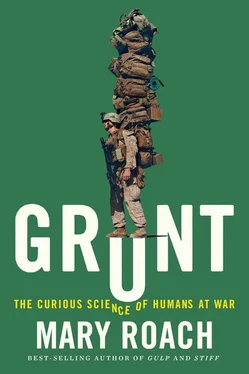Early in 2002, with Hollywood’s appetite for action dramas dampened by the events of 9/11, Segall began repurposing his talent for gore and violence. He founded a company, Strategic Operations, to produce loud, stressful, hyper-realistic (the coinage has been trademarked) combat simulations for training military personnel: the fog of war, in a box. Many of the trainees are corpsmen (Navy medics who deploy with Marines and SEALs)—men and women whose job may require them to perform emergency procedures while guns are going off around them and people are screaming and dying and bleeding like garden hoses. The underlying concept is “stress inoculation.” If you’re thrown into a staged ambush in Stu Segall’s Afghan village mock-up, the thinking goes, you’ll be calmer and better prepared when the real shit hits overseas. For medics, being calmer matters a lot. The fight-or-flight response is helpful if you’re fighting or taking flight but, as we’ll see, fairly catastrophic if you’re trying to stanch the flow of blood from an artery or cut an emergency airway or just generally think fast and clearly.
Forty future corpsmen for the 1st Marine Division, headquartered in nearby Camp Pendleton, are here today as part of a combat trauma management course. Over the course of two and a half days, the trainees will administer pretend emergency care to role-players, most of them Marines, in six varieties of military pandemonium, beginning with an 8:00 a.m. insurgent attack in the Afghan village.
The village, the largest of Segall’s sets, consists of two dozen ersatz mud-brick buildings, a small market, a rusting swing set, and, until recently, goats. (The goats were dismissed, because someone had to come in over the weekend to feed them, and more often than not it was Segall.) To get close to the action, I requested a role. I will be playing myself: a reporter who gets in the way and distracts people from their jobs. They’ve placed me in a sparsely furnished two-room house with a seasoned medical role-player named Caezar Garcia.
Under a torn pant leg, Caezar wears a simulated skin sleeve—silicone encrusted with mock gore and plaster bone fragments. A simulated severed artery will bleed via a small pump connected to three liters of house-brand special effects blood that Caezar wears in a concealed backpack, a sort of CamelBak for vampires. The flow is controlled by a wireless remote, so it can be stopped or slowed or allowed to continue unabated, depending on how competently the corpsman has placed the tourniquet. Originally the instructors, who hover on the fringes of the action during scenarios, held the remotes. Caezar, wanting a more nuanced bleed, petitioned to control it himself.
“I said, ‘Look, once you bleed me out—’” Caezar stops to listen. The call to prayer has started. The recording, being played over a set of speakers on a tower at the center of the village, is the signal for the role-players and the pyrotechnics guy to take their places. Through a window to our left, the trainees can be seen entering the village. They walk in formation, armed and armored, looking unrelaxed. The tape-recorder muezzin finishes his call, and for a moment it’s quiet. I can hear the soft, plasticky thrum of Caezar’s blood pump.
And then I can’t. First comes the familiar high whistle of an explosive-powered projectile, a sound that, depending on your life experience, presages pretty lights in the summer sky or a rocket-propelled grenade explosion. Rifle fire follows. The ammo is blanks, but you wouldn’t necessarily know that, because the pyrotechnics guy sets off an accompanying “dust hit” on the ground or wall.
The muezzin’s voice has been replaced by a recording of whizzing, ricocheting bullet noises and panicked soldiers yelling. It sounds like it was a hell of a battle. (I asked Segall about it later. “Vietnam?” “ Saving Private Ryan. ”) You wonder what they make of it over at the Water Authority.
“OOOOOH, FUCK! AAAAAAOHH HELP ME!” That’s Caezar. He’s very good.
A trainee steps into the room. His gaze drops to the floor, to a foot, in a boot, nowhere near a leg. Bone and mangled flesh—the remnants of a lower leg, sculpted by “wound artists” working from photos of a real injury—protrude from the boot. The corpsman blurts out, “Are you okay?”
Years ago, crossing a street with my friend Clark, we looked down to see a smear of blood and feathers marginally recognizable as a pigeon. Clark bent over and yelled, “Are you okay?” The line is less funny now but equally ludicrous. A small blood lake expands on the floor. And here is where things go hyper-realistic: Unbeknownst to this corpsman, Caezar is an amputee. [21] And the founder of Missing Something, my second-favorite amputee organization name, after Stumps R Us. I attended a Stumps bowling party in the 1990s, which served as my official introduction to the awesomeness of Hosmer Upper Extremity Prosthetics sporting attachments. In addition to the Bowling Attachment, Hosmer makes a Baseball Glove Attachment, and the pole-gripping Ski Hand/Fishing Hand. The Hosmer-equipped bowlers kicked my ass.
He wears the silicone sleeve over the stump of his leg. When he jerks it around, as he is doing now, it trails an arc of blood. Blood is flying like champagne in the locker room after the big win.
Outside the door, instructors are yelling to get the other wounded “off the X”—out of sight, out of the kill zone. They’re dragged into the room adjoining ours. The floor is men: role-players on their backs and trainee corpsmen crouched around them. One figure stands out for being unusually barrel-chested. This is the Cut Suit actor. You may be familiar with “patient simulators” like Resusci Anne, upon whom first responders practice their skills. The Strategic Operations Cut Suit is a “human-worn” patient simulator. The actor dons a vestlike rib cage with an insert tray of abdominal organs and, over this, a kind of flesh-tone wetsuit—simulated skin that bleeds when it’s pierced, via the same pump-and-tube system Caezar uses for his stump. (It also “heals,” with help from the Cut Suit Silicone Repair Kit.) It’s as though someone crawled inside Resusci Anne and gave her the one thing patient simulators, for all their bells and whistles, will never have: humanity. SimMan may bleed and pee and convulse, his tongue may swell and his bowels may rumble, but he will never sit up, drill his gaze into a student’s eyes, and plead, as Caezar just did, “Get me out of here, this is a bad neighborhood, man!”
Today’s Cut Suit actor isn’t yelling, because his character has been shot through the chest and his lung has collapsed. He takes shallow panicky breaths while a trainee, whose uniform identifies him as Baker, gets ready to do a needle decompression. When a bullet or broken rib punctures a lung, inhaled air begins to fill the cavity that houses the lung. The air builds up and soon the lung can’t expand, and breathing becomes a struggle. It’s called pneumothorax, from the Greek for air and chest , and it is the second most common cause of combat death. Baker’s task is to insert a needle catheter to release the air and relieve the pressure. He’s sweating. His glasses slide down his nose. He holds the needle near the role-player’s collarbone, which is not between any of his ribs, or even part of the Cut Suit.
“Are you FUCKING SERIOUS, BAKER?” You know the exaggerated TV cliché of the scary yelling Marine instructor? It’s not exaggerated. “That’s his clavicle. You almost actually stabbed him.”
Presently the needle finds its mark, an occlusive bandage is applied, and the role-player is loaded onto a stretcher. Baker picks up the stretcher’s front handles without alerting the trainee at the other end, causing the patient and the $57,000 Cut Suit to tumble onto the ground.
Читать дальше












